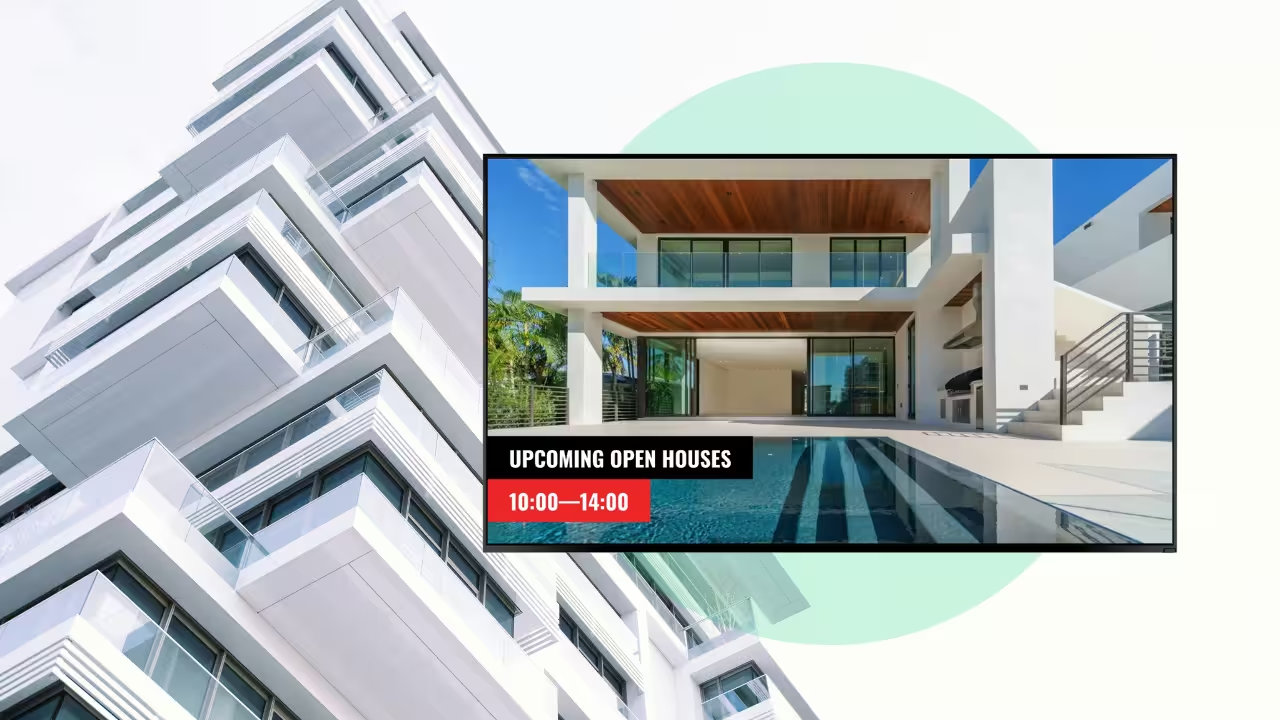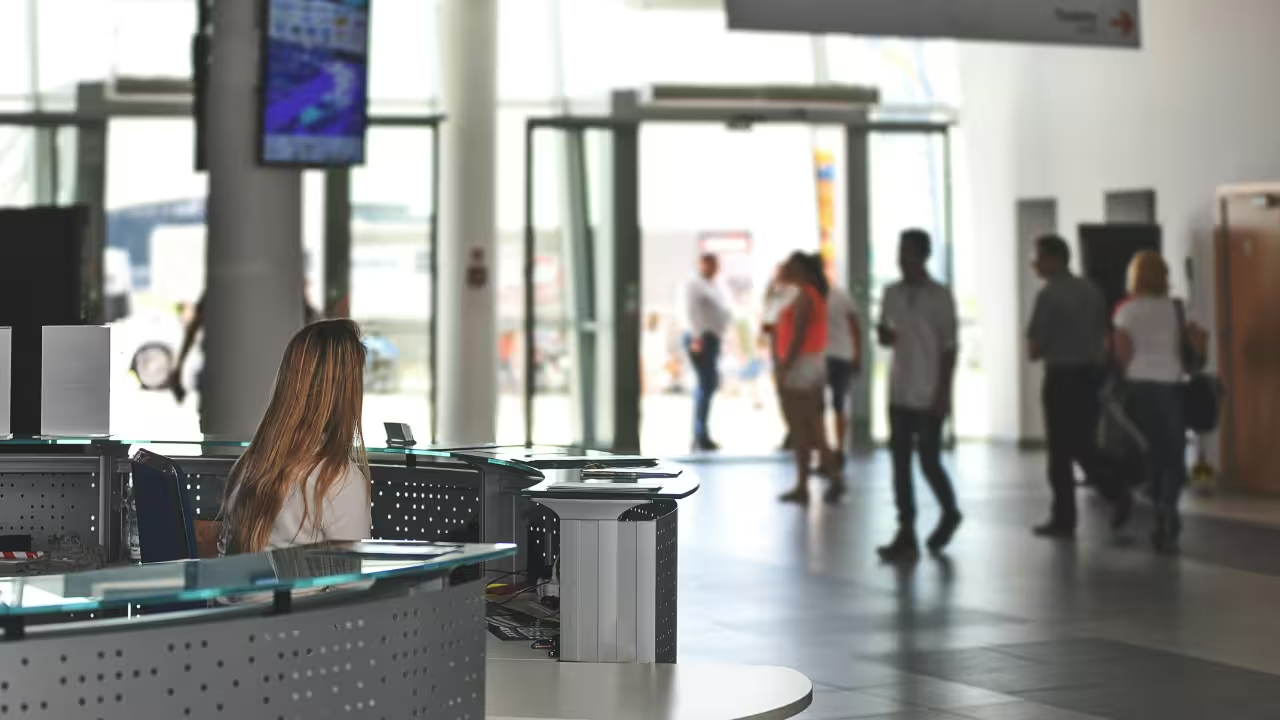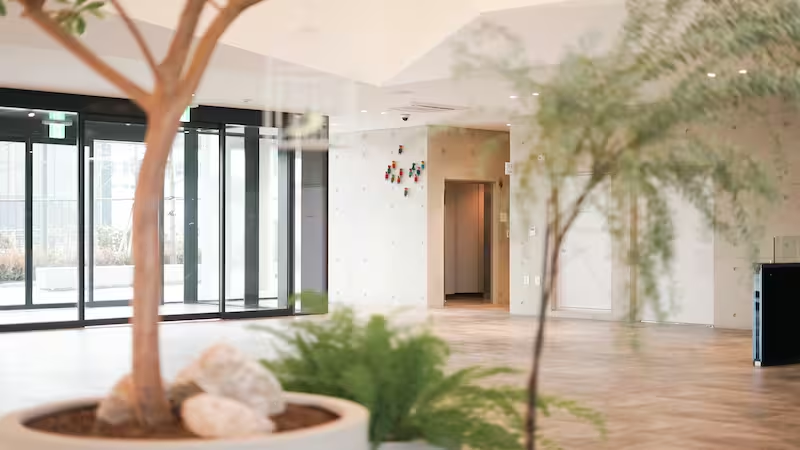
Table of Content
You simply cannot afford to ignore the role of digital signage in shaping how your real estate brand is experienced in person. Clients may start their journey online, but their perception of your professionalism, efficiency, and market expertise is often formed when they step into your space.
Real estate digital screens can show attractive visuals of your listings, yes, but they’re also where clients get to see the faces behind the business, hear stories from other buyers and sellers, and understand what you stand for. That’s why people stay a little longer, ask better questions, and start to picture what working with you might actually feel like.
In this article, we’ll break down what real estate digital signage is, how it works, the benefits it offers, and real-world examples of how real estate professionals are using it to inform, attract leads, and streamline marketing across locations.
What Is Real Estate Digital Signage
Real estate digital signage is the use of a network of connected screens and displays to market properties and services in a dynamic and engaging way. It can be used by agents, brokerages, developers, property managers, and leasing teams to attract attention, deliver information, and improve the client experience.
It has three main components:
1. Hardware – This typically involves the screens such as window displays, lobby screens, or interactive kiosks, and the media player that connects each display to the internet and streams content smoothly.
2. Software – Instead of relying on USB sticks for every update, signage software gives you a central cloud-based dashboard where you can design content, schedule what plays when, and update screens remotely from any device.
3. Content – This includes listing photos, video tours, agent profiles, testimonials, live market stats, or interactive tools that let buyers explore listings by price, type, or location.
Once you design your content in the software, or drag your existing media files to the dashboard, you assign it to a playlist and hit publish. The CMS then sends a command over the internet to the media player which downloads the content and displays it on the connected screen, according to the schedule you set.
Because it’s a networked system, real estate signage isn’t limited to one office. You can standardize your brand presence across multiple locations while still tailoring content locally, for example, showcasing waterfront homes in one branch and urban condos in another.

The Benefits of Digital Signage for Your Real Estate Business
Your 24/7 Marketing Presence
Once you install digital window signage at your storefront, the screens work around the clock, which is a critical advantage because home searches today often happen during non-traditional hours. A potential client walking or driving by late at night can instantly view available listings on high-resolution photos, or scan a QR code to launch a virtual tour directly on their smartphone. Studies show that the recall rate for advertising signage is an astounding 83%, which is more than twice as high as traditional advertising, and businesses with digital displays can see a 29.5% increase in sales. You're not only attracting passerby's attention but also empowering them to take immediate action on their own schedule.
Easy Content Updates and Automation
A content management system will give your team back hours and make their life significantly easier when it comes to managing your digital displays. They can log into the cloud-based dashboard from anywhere to add a new listing, change a price, or remove a sold property from the screen with just a few clicks. Pre-designed templates make it easy to keep the content polished and on-brand, while scheduling tools allow you to automate updates weeks in advance. For even greater efficiency, you can connect your displays to your listings database or CRM so that pricing, availability, and agent details update automatically without manual input.
A More Engaging Way to Sell
Property marketing displays let you bring properties to life in ways that match how buyers actually search today through immersive, media-rich experiences. Research shows that listings with video can receive more than four times the inquiries of those without, and homes marketed this way often sell faster.
On a storefront screen, you can showcase:
- Video walkthroughs and drone footage that help potential buyers imagine the space before they ever schedule a visit.
- High-resolution galleries that highlight finishes, layouts, and neighborhood views in with screens capable of playing up to 4K UHD quality.
- Interactive elements, such as QR codes that launch virtual tours or connect viewers directly to the agent’s calendar.
People walking by at night, weekend shoppers, or commuters stuck in traffic all get a real-time look at what’s available. And because the content is digital, you can rotate between premium listings, neighborhood highlights, or even short testimonials from past clients to reinforce trust.
Analytics to Fuel Your Strategy
Before deployment, it's always advisable to collect baseline data, which will help you accurately measure the impact of your new digital displays. Digital signage software can give you clear proof of play by showing exactly how long your content runs and how many times a video loops. You can view these insights on a dashboard or have CSV reports sent directly to your inbox. This data allows you to directly compare your performance before and after deployment to get a clear measure of improvement.
You can also generate trackable QR codes, so when a potential client scans one of these codes on your screen, you can track the performance to the linked web pages and see which listings are generating the most interest and driving the most traffic.
A Modern, Tech-Savvy Appeal
In an industry where first impressions are everything, using real estate screens instantly positions your business as a modern, forward-thinking, and trustworthy brand. When a client walks into an office with dynamic, professional screens, they immediately perceive your agency as more capable and tech-proficient, all of which gives them a distinct reason to choose you over the competition.
Learn how real estate signage actually works
Generate Revenue by Selling Ad Space
Your screens in high-traffic areas like busy intersections, shopping centers, or popular neighborhoods can double as advertising real estate. Relevant local businesses, like mortgage lenders, interior designers, home stagers, and insurance agents, are often looking for targeted exposure. You can collaborate with them to provide ad spaces that reach people already in the home-buying process, right from your office or display window. You set the rates, choose who gets to advertise, and keep full control over what shows up.

Typical Use Cases for Real Estate Digital Signage
Real Estate Agencies
For use in office lobbies, storefront windows, or open houses
- Promote listings with high-quality photos and property videos
- Play virtual tours and 360° walkthroughs to capture buyer interest
- Highlight key features, pricing, agent contacts, and availability
- Share market updates or new listing alerts to walk-in clients
- Reinforce your brand with logo loops, testimonials, or team profiles
Property Developers and Builders
For use in showrooms, model units, construction sites, or sales offices
- Showcase floor plans, finishes, or design options through visual content
- Display real-time construction updates or stage-by-stage progress videos
- Present pricing tiers, unit availability, or booking instructions
- Highlight upcoming projects or investment opportunities
Property Management Companies
For use in residential complexes or leasing offices
- Share announcements, maintenance schedules, or local event news
- Help prospects navigate available units, pricing, and move-in offers
- Introduce on-site staff and contacts for resident support
- Promote commercial spaces available within mixed-use developments
Shopping Centers & Commercial Properties
In entrances, corridors, or retail-facing areas
- Highlight available units and leasing opportunities
- Promote anchor tenants, foot traffic stats, or floor plans
- Display local events, seasonal campaigns, or public notices
- Use wayfinding content to improve customer flow
Hotels, Aparthotels & Coworking Spaces
In lobbies, elevators, meeting areas, or shared kitchens
- Display room or space availability in real time
- Promote onsite services, partner businesses, or upcoming events
- Share branded welcome messages or check-in instructions
- Provide info on nearby dining, transport, or attractions
Real-World Implementation of Digital Screens in Real Estate
Florin Parners - Stockholm, Sweden
Florin Partners, a real estate agency in Stockholm, Sweden, wanted to bring their office space to life and engage with people passing by with videos, infographics, and statistics about their residential and commercial listings. They installed two screens in their window and set up additional displays in a gallery format behind them.
Using Look as the content management system, the firm can now update all of its screens from a cloud-based dashboard. The software is so user-friendly that every member of the staff has the expertise to manage the content themselves. This has made the process incredibly flexible, as co-founder Jonathan Florin said, "I can sit in the Bahamas and do this as well as here in Stockholm."
RE/MAX Metro - St. Petersburg, Florida
RE/MAX Metro, a real estate agency based in St. Petersburg, Florida, upgraded its storefront to make better use of their window space, both for attracting foot traffic and improving in-office communication.
Their deployment involved:
- Dual-Sided Displays: One side faces pedestrians, showcasing listings and agent highlights. The reverse side faces inward, delivering internal messages and updates.
- Built for the Elements: With a brightness of 3,000 nits and dust resistance, these panels stay readable and durable and run 24/7 without overheating.
- Simple Setup, Maximum Impact: All it takes is a power and LAN cable. No tangled cords, no bulky gear. Clean, functional and looks professional.
The setup not only elevated their brand presence but also allowed them to monetize screen space. By offering limited ad placements to local and national partners, the agency now earns roughly $5,000 per year in additional revenue.
Modernize Your Property Marketing with Confidence
Digital signage for real estate changes your property marketing from a time-consuming, manual process into an automated system that showcases your properties professionally, day and night. The most successful agents and property managers are already making this shift, and it's becoming the new standard in real estate marketing.
You gain a real competitive edge that delivers results through better exposure, lower marketing costs, and the professional image that attracts quality prospects.
Ready to see how a straightforward platform can upgrade your property marketing and give you that competitive advantage? Discover how easy it is to manage and update your real estate marketing screens with Look Digital Signage.



.avif)



